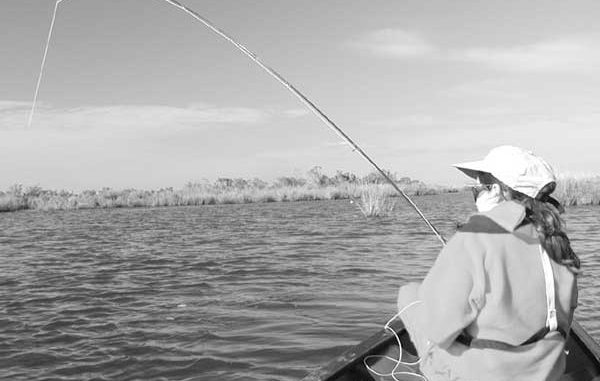
This hunter doesn’t have a lot of time to scout, so he uses timers to know when to be in the woods.
“Hey dawtee, guess why Mars is red?”
My daughter was observing the planet through her binoculars. I anticipated some enlightenment from her 8th grade science class.
“Why is that, Cokie?”
“Because it’s full of redfish.”
She’s a late bloomer among her siblings with respect to fly fishing, and may never attain the expert status her older brothers have. But with that attitude, she’s definitely reinforcing her position as the apple of her daddy’s eye.
Two years ago in October, she made her first venture into salt water. We opted for Golden Meadow, despite a brisk north wind.
Still, it was still an impressionable first trip. She caught her first fly rod red of 14 inches. It ate a pink charlie sitting on the bottom while she was grabbing for a soft drink (Cormier’s 7th Law: An unwatched line catches fish). She also landed a couple of dozen small specks.
A year later, Cokie was anxious to return to the Meadow. The tide forecast looked good — moderate in range and falling all day.
It was a calm, crisp morning. Just the kind that has every angler’s anticipation running high. This time we pulled up to a crowded launch with the canoe instead of the boat, thinking we might sneak up to the Spottail Elvis in the skinny-water ponds. But we also had the trolling motor to get us out to Catfish Lake.
The water was still too high in the ponds. So we motored out through a pair of canals to the edge of the lake. On our way there, I noticed a large wake around a cluster of pipes. My first instinct was sheepshead, but then I spotted a bronze back.
Cokie cast a size 2 Perch Float Popper several feet ahead of it, and waited until it approached to give the popper motion. A head broke through the surface, and inhaled the popper. After coaching her through a prolonged fight, the 25-inch red slipped into the net. The fish was worn out, but so was my girl!
By now I noticed gulls diving where the canal entered the lake. Immediately, I tied on a 1/50 ounce chartreuse Clouser about 2 feet under a vosi, and motored us to the spot.
Cokie made a 20-foot cast, stripped the line — which popped the vosi — and then let it pause for a moment. Suddenly, the vosi disappeared. She lifted the rod, and brought a 13-inch speck to the gunnel. This continued for almost 2 hours, until it was time for lunch.
So what’s a vosi?
Vosi comes from the acronym V.O.S.I., which stands for “Vertically Oriented Strike Indicator.” Take a 1-1/2 inch sytrofoam perch float, cut it in half, and you have two of these. Some might call it “half a perch float,” but the fly rodder who casts a $500 rod will never admit to using a perch float.
Take a Dremel sanding bit and manually eat a concave face into the flat end. When rigging, slip the concave end up the leader toward the fly line. You essentially have a fly rod popping cork. Adjust the cork using the plastic pin so it resides about 16 to 24 inches above the fly. Stripping pops the cork, and that attracts specks, reds, drum and other species.
The vosi originated a decade ago from the Perch Float Popper created by Kirk Dietrich of Chalmette. The PFP involved cutting a groove in the body, supergluing it to a Mustad 34007 hook, painting the body and eyes with acrylic paint, and then coating with waterproof epoxy.
These were quick and easy poppers, except the orange half of each float required at least 2 primer coats of white. So I suggested to Kirk that we dispatch with the hook and painting, and just try using the orange halves as a mini popping cork.
On its maiden trip, the cork exceeded all expectations. With a club tournament coming up, I knew using a cork wouldn’t pass the qualifications, so I said it wasn’t a cork, it was a “vertically oriented strike indicator.” Years later, the Louisiana Legislature would follow my example to deny they were promoting gambling, only “gaming.”
After lunch, Cokie and I trolled up to a deadend canal off the northeast corner of Catfish Lake. The instant her first cast hit the water, the vosi raced off at a right angle. The way her rod was bent, and the fish fighting down, I thought “probably a red.” But it turned out to be a 17-inch speck.
More rod-bending action was observed by a passing boat, which quickly shut down and moved to the other side of the canal. Like missiles out of a silo, four sets of popping corks and baited hooks came flying out the boat, and crashed into the middle.
That didn’t stop the action on our end. Cokie was now consistently into 14- to 16-inch trout. Meanwhile, the four anglers in the neighboring boat were still struggling. After 20 minutes, they gave up and headed elsewhere.
“Clear water favors the fly fisherman, right Dad?”
“You bet, sweetheart!”
No sooner had she said this when the rod was almost doubled. The fish made several runs around the canoe, before finally coming up. When it did, Cokie’s face lit up and my eyes bulged. This speck was over 3 pounds. In an act of kindness, she decided to let it go. We already had more than enough fish in the ice chest anyway.
As we headed back to the launch, I was suddenly startled by a strange sound.
“CAW! CAW!”
For a second I thought a crow had landed in the canoe.
“What the heck was that?” I asked, finally realizing she was the source.
“Grandma says every mother crow thinks her littlest crow shines the most.”
On this day, Cokie did indeed shine the most!
